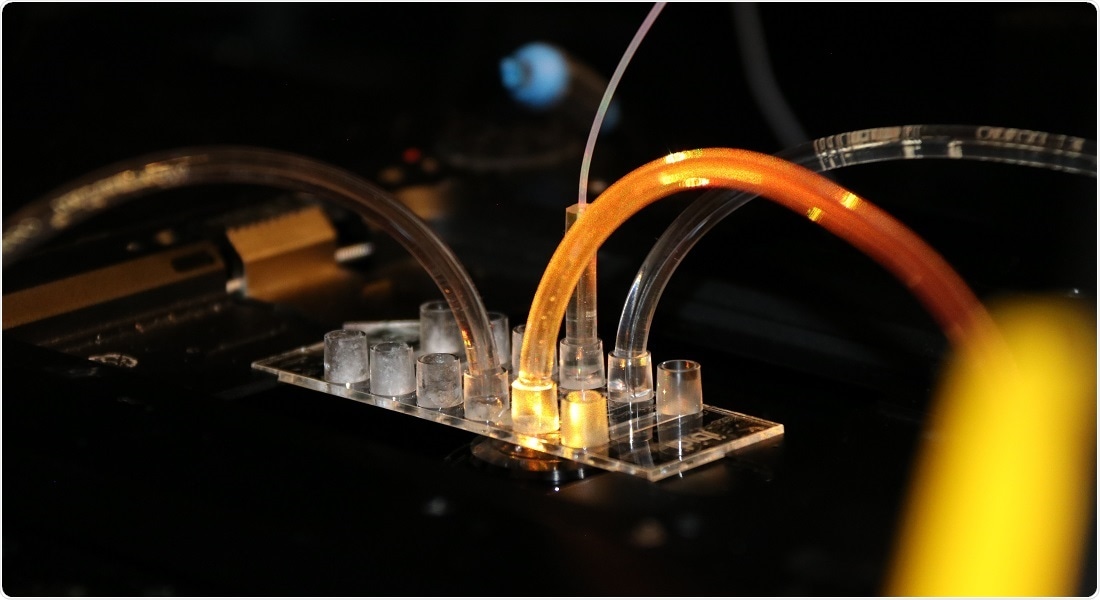With the help of artificial intelligence (AI), scientists from the University of Copenhagen have solved a crucial issue that, to date, has been a major barrier to significant protein research into the dynamics behind various diseases, like Parkinson’s, Alzheimer’s, cancer, and also in the development of novel gene-editing techniques and sustainable chemistry.

Sample containing proteins that are studied using the FRET technique. Image Credit: Shunliang Wu.
The analysis of large datasets collected by scientists has always been a challenging and time-intensive task. This is because scientists often use the FRET technique and microscopy to observe how proteins migrate and communicate with their environments. The task also needed a high level of proficiency. This, thus, results in the proliferation of hard drives and stuffed servers.
Currently, a research team, from the Department of Chemistry, Nano-Science Center, Novo Nordisk Foundation Center for Protein Research, and the Niels Bohr Institute, has designed a machine-learning algorithm to perform the arduous tasks.
We used to sort data until we went loopy. Now our data is analysed at the touch of button. And, the algorithm does it at least as well or better than we can. This frees up resources for us to collect more data than ever before and get faster results.”
Simon Bo Jensen, Biophysicist and PhD Student, Department of Chemistry and the Nano-Science Center
The machine learning algorithm has learned to identify the patterns of protein movement, enabling it to categorize the data sets in seconds—a process that normally takes specialists several days to complete.
Simon Bo Jensen added, “Until now, we sat with loads of raw data in the form of thousands of patterns. We used to check through it manually, one at a time. In doing so, we became the bottleneck of our own research. Even for experts, conducting consistent work and reaching the same conclusions time and time again is difficult. After all, we’re humans who tire and are prone to error.”
Just a second’s work for the algorithm
The researchers from the University of Copenhagen have performed studies about the association between the movements and functions of proteins. These studies have been globally recognized and are crucial for interpreting the function of the human body. For instance, diseases like Parkinson’s, Alzheimer’s, and cancer are caused when protein clump up or alter their behavior.
The novel gene-editing technology, called CRISPR and which received the Nobel Prize in Chemistry in 2020, also depends on the proteins’ ability to cut and splice particular sequences of DNA. Guillermo Montoya and Nikos Hatzakis, both researchers from the University of Copenhagen, always use microscopy data to explore how these processes actually occur.
Before we can treat serious diseases or take full advantage of CRISPR, we need to understand how proteins, the smallest building blocks, work. This is where protein movement and dynamics come into play. And this is where our tool is of tremendous help.”
Guillermo Montoya, Professor, Novo Nordisk Foundation Center for Protein Research
Attention from around the world
It seems that protein scientists across the world have been missing this important tool. Many international research teams have already presented themselves and were keen on using the machine-learning algorithm.
This AI tool is a huge bonus for the field as a whole because it provides common standards, ones that weren’t there before, for when researchers across world need to compare data. Previously, much of the analysis was based on subjective opinions about which patterns were useful. Those can vary from research group to research group. Now, we are equipped with a tool that can ensure we all reach the same conclusions.”
Nikos Hatzakis, Research Director and Associate Professor, Department of Chemistry, University of Copenhagen
Hatzakis is also an Affiliate Associate Professor at the Novo Nordisk Foundation Center for Protein Research. He further added that the tool also provides a different perspective.
“While analyzing the choreography of protein movement remains a niche, it has gained more and more ground as the advanced microscopes needed to do so have become cheaper. Still, analyzing data requires a high level of expertise. Our tool makes the method accessible to a greater number of researchers in biology and biophysics, even those without specific expertise, whether it’s research into the coronavirus or the development of new drugs or green technologies,” Hatzakis concluded.
Source:
Journal reference:
Thomsen, J., et al. (2020) DeepFRET, a software for rapid and automated single-molecule FRET data classification using deep learning. eLife. doi.org/10.7554/eLife.60404.